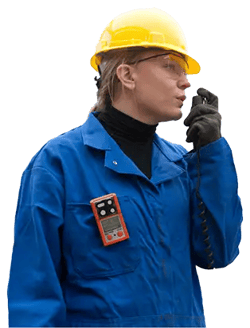No matter how large your gas detection fleet is, managing it can pose challenges and hidden costs: lost productivity during downtime, diversions from other tasks, and parts or replacements, to name a few. Once regular maintenance falls behind other duties and gas detectors begin to fail, it can become a slippery slope to keep up with repairs while equipping workers with the safety devices they need with rentals, spares, or even new detectors.
Despite the challenges of fleet management, it’s crucial to reduce the chances of a worker being hurt or killed on the job.
Maintenance ensures that your gas detectors will perform at their best and that workers can depend on them to work when hazards arise. How do you make sure that your gas detection equipment is accurate and reliable while minimizing the time and money you spend maintaining it?
Bump Tests and Calibration
Regular maintenance, like bump tests and calibration, is a large part of keeping your gas detectors healthy. These tests aren’t difficult, but they are easily overlooked as workers focus on getting started on their work for the day.
Bump testing is the process of exposing the sensors in your gas detector to a concentration of gas that is higher than the alarm set points. Bump testing before each use is the only way to know that your gas monitor is responding to alarms as it should. However, a successful bump test doesn’t guarantee accuracy—it simply proves that the sensors are still picking up gas concentrations above the set point and that alarms are working.
.jpg?width=540&height=260&name=calibration%20bump%20testing%20540%20260%20(1).jpg)
To check the accuracy of your gas detectors, it’s essential to calibrate them once a month (or according to your company’s standards) by exposing them to a known concentration of calibration gas for a specific amount of time to reset the reference point for future readings. This combats sensor drift or gas readings impacted by poisons or inhibitors.
For some sites with extra time or small quantities of gas detectors, manual bump tests and calibration make sense. However, docking stations automate the process to make it fast and easy—workers simply dock their monitors at the end of each shift and the docking stations perform the tests and collect data so safety managers can verify that the detectors are safe to use without training workers on manual processes.
For companies with a large fleet of gas detectors, docking stations provide a reliable way to ensure that workers are consistently bump testing and calibrating on schedule with easy-to-access reports.
Replacements, Troubleshooting, and Repairs
If you perform repairs on-site, broken monitors can mean downtime for weeks if you need to order parts or don’t have the right personnel available.
By combining docking stations with a gas detection maintenance service like iNet® Exchange, you can stay ahead of downtime with proactive repairs. If the docking station senses a decline in performance, and we send replacements before you even realize that the gas detector is going to fail.
Not only that, but not every facility has employees with the expertise to identify and make complicated repairs. By letting the experts handle it, you can depend on the gas detectors to work in vital moments, and you may be able to downsize your fleet by eliminating the need for spare equipment.
Compliance Reporting and Hazard Visibility
How do you know who last used a gas monitor or what they were exposed to? What behaviors might have affected alarms or incidents? What is the status of your fleet? Where are your reports stored? It can be nearly impossible to collect or keep track of all of this information manually.
iNet® Control management software stores this data in one dashboard so that you never have to dig through paperwork for compliance reports or incident investigation again.
Let’s look at how all of these services might combine to create a safety program that’s cost-effective, efficient, and safe, with minimal labor from your team.
Automated Gas Detector Fleet Management in Action
On a regular day in this facility, multiple gas monitors need maintenance and repair. Without functioning gas monitors, work can't get done safely or on time. The responsibility to fix these monitors falls on a select few people who are often unable to complete their other tasks because they're spending hours troubleshooting and waiting weeks for spare parts to arrive.
However, this site recently deployed gas detection fleet management solutions, allowing them to avoid the all-too-common pitfalls of gas detection maintenance. When gas monitors are placed on docking stations, they automatically perform bump tests and calibrations, identify current failures, and predict future issues. Replacement instruments arrive at the factory within 24 to 48 hours.
Additionally, important compliance information about critical alarms, instrument usage, and overdue bump tests and calibrations are sent to iNet Control where the safety managers can check on the health and performance of their gas detection program via the web app or regularly scheduled emails.
By automating maintenance and repairs, this site has:
- saved countless labor hours on troubleshooting and repairs
- effectively managed a budget by establishing a predictable monthly spend
- reduced their overall fleet size by eliminating the need for unnecessary spares
- improved visibility into team behavior, critical equipment failures, and gas exposures
- hasn't compromised safety by creating an environment where work can get done safely and on time.
With a scalable gas detection fleet management solution like iNet Exchange, you can improve maintenance processes for a fleet of any size to make your facility safer and more efficient.
Read more about your gas detection maintenance options in our eBook: Take the Pain out of Gas Detector Maintenance.



